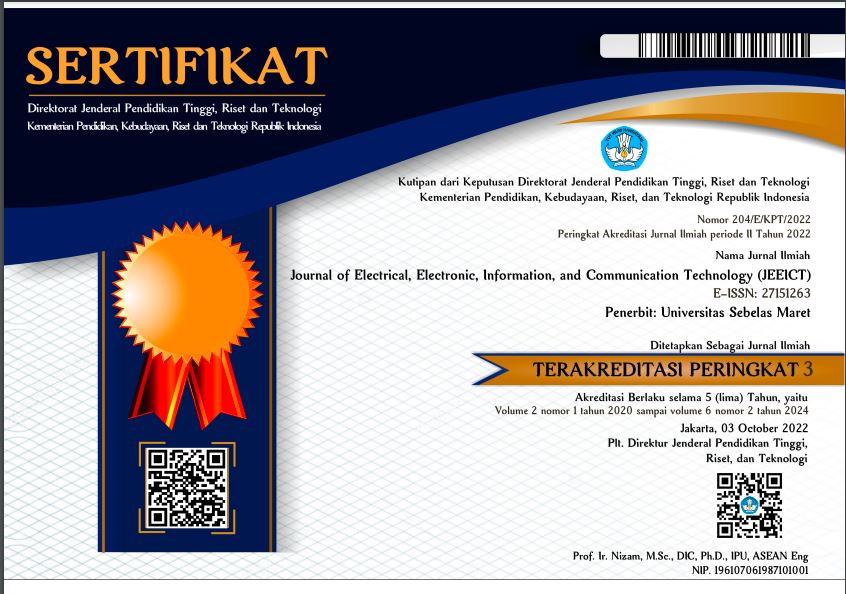Yawing based IoT Monitoring System to Improve Horizontal Axis Wind Turbine Performance
Abstract
The diminishing availability of non-renewable energy resources such as coal, oil, and natural gas has prompted efforts to seek sustainable energy alternatives. One promising alternative is wind energy, which can be converted into electricity through wind turbines. However, Horizontal Axis Wind Turbines (HAWTs) have limitations in capturing wind from various directions, affecting operational efficiency. Therefore, this research attempts to address this issue through an innovation in yawing-based monitoring systems integrated with HAWTs and Internet of Things (IoT) technology. The yawing-based monitoring system is designed to monitor the performance of HAWTs in real time, including wind speed, rotations per minute (rpm), electrical current, and voltage. Data obtained from this monitoring system is used to identify potential damage to HAWTs, enabling timely preventive measures. Furthermore, this monitoring system can enhance the operational efficiency of HAWTs, reduce maintenance costs, and extend their lifespan. The results obtained from the comparison between the conventional system and the system with active yawing show a significant increase in power generated by the turbines equipped with the active yawing system. On average, turbines with the conventional system produce 213 watts of power, while turbines equipped with the active yawing system reach a power output of 296 watts. This represents a 39% increase in turbine efficiency, enhancing wind energy capture efficiency. These findings confirm that the integration of the active yawing system can optimally align the turbines with the incoming wind direction, thereby improving the overall system performance.
Full Text:
PDFReferences
BAPPENAS. (2023, September 27). BAPPENAS. (BAPPENAS) Retrieved February 12, 2023, from https://www.bappenas.go.id/id/berita/diversifikasi-sumber-listrik-untuk-ketahanan-dan-kemandirian-energi-indonesia-12wdl
Gao, Y. L. (2020). Improved grey wolf optimization for identification and correction of yaw error in wind turbines. Renewable Energy , 162, 719-732.
Nasiruzzaman, A. M. (2018). Energy, economic and environmental analysis of HAWT (horizontal axis wind turbine) and VAWT (vertical axis wind turbine) using Monte Carlo simulation. Energy , 151, 1114-1124.
Pratama, R. Y. (2020). Monitoring Turbin Angin Menggunakan Smartphone Android. JTEV (Jurnal Teknik Elektro dan Vokasional) , 6, 64-71.
Selviyani, S. (2016). Rancang Bangun Sistem Monitoring Arus dan Tegangan Dc Berbasis Mikrokontroler Atmega32 pada Turbin Angin Horizontal Axis. Skripsi .
M-G Kim, & P H Dalhoff. (2014). Yaw Systems for wind turbines – Overview of. Journal of Physics: Conference Series (524), 2.
ZAFAR, U. (2018). LITERATURE REVIEW OF WIND TURBINES. Weimar: Bauhaus Universität.
Jian Yang, Lingqi Fang, Dongran Song, Mei Su, Xuebing Yang, Lingxiang Huang, et al. (2020). Review of control strategy of large horizontal-axis wind turbines yaw system. Wind Energy , 24 (4), 97-115.
McKenna, R, vd Leye, P.O, & Fichtner, W. (2016). Key challenges and prospects for large wind turbines. Renew. Sustain. Energy Rev , 53, 1212-1221.
Song, D.; Fan, X.; Yang, J.; Liu, A.; Chen, S.; Jo. (2018). Power extraction efficiency optimization of horizontal-axis wind turbines through optimizing control parameters of yaw control systems using an intelligent method. Appl. Energy , 224, 267–279.
Karakasis, N.; Mesemanolis, A.; Nalmpantis, T.; Ma. (2016). Active yaw control in a horizontal axis wind system without requiring wind direction measurement. IET Renew. Power Gener , 10, 1441–1449.
Shariatpanah, H., Fadaeinedjad, R., & Rashidinejad, M. (2013). A new model for PMSG-based wind turbine with yaw control. IEEE Trans. Energy Convers , 28, 929–937.
Song, D., Yang, J., Fan, X., Liu, Y., Liu, A., Chen, G., et al. (2018). Maximum power extraction for wind turbines through a novel yaw control solution using predicted wind directions. Energy Convers. Manag. , 157, 587–599.
Saenz-Aguirre, A., Zulueta, E., Fernandez-Gamiz, U., Lozano, J., & Lopez-Guede, J. (2019). Artificial Neural Network Based Reinforcement Learning for Wind Turbine Yaw Control. Energies , 12, 436.
Saenz-Aguirre, A., Zulueta, E., Fernandez-Gamiz, U., Ulazia, A., & Teso-Fz-Betono, D. (2019). Performance enhancement of the artificial neural network–based reinforcement learning for wind turbine yaw control. Wind Energy .
Refbacks
- There are currently no refbacks.







